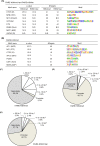Characterization of Chromatin Structure-associated Histone Modifications in Breast Cancer Cells
- PMID: 23166525
- PMCID: PMC3492650
- DOI: 10.5808/GI.2012.10.3.145
Characterization of Chromatin Structure-associated Histone Modifications in Breast Cancer Cells
Abstract
Chromatin structure and dynamics that are influenced by epigenetic marks, such as histone modification and DNA methylation, play a crucial role in modulating gene transcription. To understand the relationship between histone modifications and regulatory elements in breast cancer cells, we compared our chromatin immunoprecipitation sequencing (ChIP-Seq) histone modification patterns for histone H3K4me1, H3K4me3, H3K9/16ac, and H3K27me3 in MCF-7 cells with publicly available formaldehyde-assisted isolation of regulatory elements (FAIRE)-chip signals in human chromosomes 8, 11, and 12, identified by a method called FAIRE. Active regulatory elements defined by FAIRE were highly associated with active histone modifications, like H3K4me3 and H3K9/16ac, especially near transcription start sites. The H3K9/16ac-enriched genes that overlapped with FAIRE signals (FAIRE-H3K9/14ac) were moderately correlated with gene expression levels. We also identified functional sequence motifs at H3K4me1-enriched FAIRE sites upstream of putative promoters, suggesting that regulatory elements could be associated with H3K4me1 to be regarded as distal regulatory elements. Our results might provide an insight into epigenetic regulatory mechanisms explaining the association of histone modifications with open chromatin structure in breast cancer cells.
Keywords: ChIP-Seq; breast neoplasms; epigenetic regulation; formaldehyde-assisted isolation of regulatory elements (FAIRE); histone modification.
Figures



Similar articles
-
Global mapping of cell type-specific open chromatin by FAIRE-seq reveals the regulatory role of the NFI family in adipocyte differentiation.PLoS Genet. 2011 Oct;7(10):e1002311. doi: 10.1371/journal.pgen.1002311. Epub 2011 Oct 20. PLoS Genet. 2011. PMID: 22028663 Free PMC article.
-
Functional elements demarcated by histone modifications in breast cancer cells.Biochem Biophys Res Commun. 2012 Feb 17;418(3):475-82. doi: 10.1016/j.bbrc.2012.01.042. Epub 2012 Jan 20. Biochem Biophys Res Commun. 2012. PMID: 22285863
-
Prediction accuracy of regulatory elements from sequence varies by functional sequencing technique.Front Cell Infect Microbiol. 2023 Aug 2;13:1182567. doi: 10.3389/fcimb.2023.1182567. eCollection 2023. Front Cell Infect Microbiol. 2023. PMID: 37600946 Free PMC article.
-
Histone modifications for human epigenome analysis.J Hum Genet. 2013 Jul;58(7):439-45. doi: 10.1038/jhg.2013.66. Epub 2013 Jun 6. J Hum Genet. 2013. PMID: 23739122 Review.
-
Formaldehyde-assisted isolation of regulatory elements.Wiley Interdiscip Rev Syst Biol Med. 2009 Nov-Dec;1(3):400-406. doi: 10.1002/wsbm.36. Wiley Interdiscip Rev Syst Biol Med. 2009. PMID: 20046543 Free PMC article. Review.
Cited by
-
Lineage-determining transcription factor-driven promoters regulate cell type-specific macrophage gene expression.Nucleic Acids Res. 2024 May 8;52(8):4234-4256. doi: 10.1093/nar/gkae088. Nucleic Acids Res. 2024. PMID: 38348998 Free PMC article.
-
Single-cell multi-omics delineates the dynamics of distinct epigenetic codes coordinating mouse gastrulation.BMC Genomics. 2025 May 8;26(1):454. doi: 10.1186/s12864-025-11619-5. BMC Genomics. 2025. PMID: 40340740 Free PMC article.
-
JUNB governs a feed-forward network of TGFβ signaling that aggravates breast cancer invasion.Nucleic Acids Res. 2018 Feb 16;46(3):1180-1195. doi: 10.1093/nar/gkx1190. Nucleic Acids Res. 2018. PMID: 29186616 Free PMC article.
-
DNA methylation and histone modifications are the molecular lock in lentivirally transduced hematopoietic progenitor cells.Biomed Res Int. 2015;2015:346134. doi: 10.1155/2015/346134. Epub 2015 Apr 19. Biomed Res Int. 2015. PMID: 25961011 Free PMC article.
-
The Epigenetic Landscape of Promoter Genome-wide Analysis in Breast Cancer.Sci Rep. 2017 Jul 26;7(1):6597. doi: 10.1038/s41598-017-06790-z. Sci Rep. 2017. PMID: 28747748 Free PMC article.
References
LinkOut - more resources
Full Text Sources
